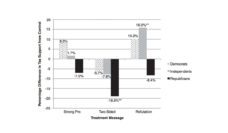Food options offered by vending machines can significantly shape what people eat. These conveniently located machines can be found across a number of settings, ranging from faith-based organizations to government agencies. They often sell food items that are high in calories, sugar, and sodium, putting many patrons at increased risk of obesity, diabetes, and heart disease. In recent years, implementation of a 100% healthy vending machine policy has become a popular intervention. However, limited information is available to fully characterize the impact of this policy approach, especially in regard to its effects on nutritional quality and the revenue generated by products sold in the machines.
To answer some these questions, we documented how the County of Los Angeles government, the largest employer in Los Angeles County, instituted a 100% healthy vending machine policy across the hundreds of facilities that it owns or leases.
In 2010, the County Board of Supervisors passed the County of Los Angeles 100% Healthy Vending Machine Policy. This institutional action required that all products sold by County-contracted vending machines meet specified nutrition standards. In 2013, one of the largest vending contracts in the County was awarded to a single vendor. One of the conditions of the contract required the vendor to provide quarterly nutritional analysis and sales data to the Los Angeles County Department of Public Health. The Department uses these data to regularly assess the nutritional quality of and the revenue generated by the sales of the products contained in the vending machines.
We found that the vending machine policy reduced the amount of unhealthy foods sold in County-contracted and operated machines. However, differences in the ease of implementing beverage standards versus snack standards were apparent.
Overall, the vendor of this new contract shared nutritional information for products from 359 vending machines. Only 297, however, remained in operation during the entire project period (November 2013-September 2015). Sales data included information on how many times each product was selected from each vending machine per month. An item was considered compliant to the Board policy if all nutrition standards were followed. Environmental scans were also conducted randomly at selected locations as a supplemental way to confirm vendor compliance and gather contextual data about the implementation process and about the pricing of the food products.
Across the 170 beverage machines and 127 snack machines included in the project, we found that the average amount of sugar purchased per beverage between 2013 and 2015 decreased by 90%. We also observed a 30% decrease in the average amount of sodium purchased per snack. Although beverage machines were nearly 100% compliant with the policy, snack machines were only 61% compliant. For all machines, the average price of products increased 32%, from $1.17 in 2013 to $1.54 in 2015. During the 23-month period, the revenue for both the beverage and snack machines decreased by more than 30%.
We found that the vending machine policy reduced the amount of unhealthy foods sold in County-contracted and operated machines. However, differences in the ease of implementing beverage standards versus snack standards were apparent. This is because the former was generally more straightforward (e.g., healthy beverages are either water or diet drinks), whereas the latter (healthy snacks) require adherence to multiple nutrient standards depending on the main ingredient(s). In the study, we found that the prices of healthier foods increased significantly upon execution of the vendor’s contract, leading to an eventual decline in revenue for both beverage and snack machines across County locations.
Instituting a 100% healthy vending machine policy requires organizational readiness and a careful consideration of the pros and cons of introducing such an action. To make the business case, advanced knowledge of where other competing vending machines are located and how they may affect patron choice is strongly advised.
Photo by Jonathan Chng on Unsplash
















